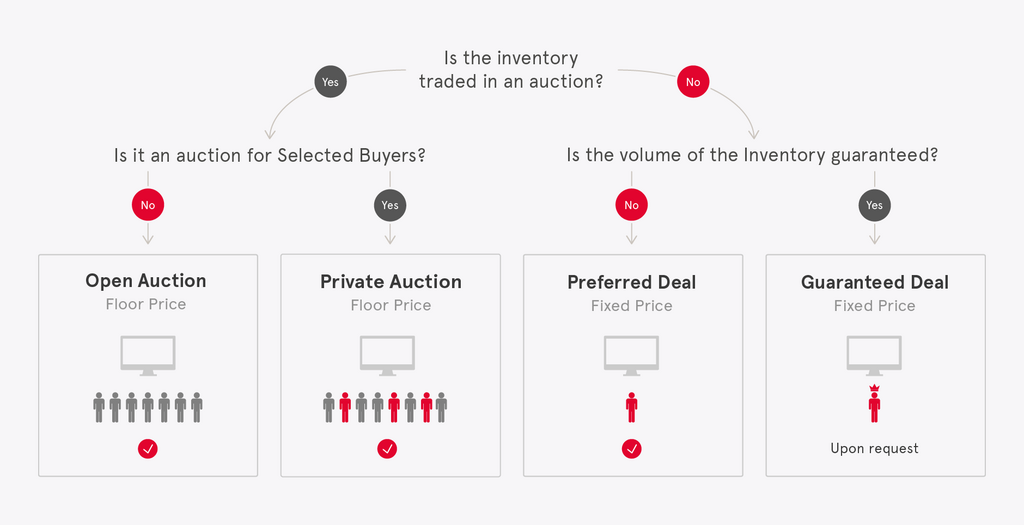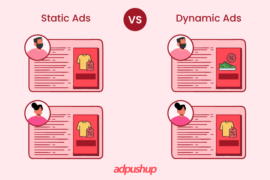Discover the benefits and drawbacks of preferred deals in digital advertising. Learn about the various types of preferred deals, their benefits, and how to set them up in Google Ad Manager (GAM).
Preferred deals are one of the most popular methods of ensuring smooth and efficient ad campaigns in the world of programmatic advertising. Programmatic is a big umbrella; open auction, private auction, preferred deal, programmatic guaranteed, and more fall under it.
In fact, the penetration of Programmatic advertising is expected to reach 91.1% in 2023. Last year, it was calculated at 90.02%. As its use is becoming more widespread, it is growing in other maturing media formats as well.
In this blog, we will dive into the Pros, Cons, and steps to set up Preferred Deals in Google Ad Manager (GAM). Whether you’re new to Preferred Deals or just looking to improve your existing strategy, this guide will provide you with valuable insights and best practices.
So, let’s get started and understand how Preferred Deals can help you drive better results for your advertising campaigns. But, first off, let’s understand exactly what is a preferred deal?
What is the Preferred Deal?
Preferred deal allows publishers to sell a part of their inventory to advertisers at a negotiated fixed price. Here, buyers have ‘first-look’ access where they can see the publisher’s inventory and then purchase it. Either publishers or advertisers can initiate this exclusive deal.
In practice, every time there is an ad request for the inventory, selected buyers will get the first (preferred) chance to bid for the inventory. If none of the buyers purchase the inventory, it is taken to the open market for auction.
Now that you know what is a preferred deal, let’s understand how it works.
How Does Preferred Deal Work?
Generally, publishers with high traffic and engaging audiences go for preferred deals. Here’s how it works:
Case 1: Publishers send invitations to buyers to participate in a preferred deal
- Interested buyers accept the invitation and get in contact with publishers. Then the terms are negotiated (price, impressions, and other requirements).
- The publisher creates a proposal as per the negotiated terms.
- Both parties review the campaign and start it.
Case 2: Buyer finds websites and pitches the deal
- Publishers respond with the requirements and negotiate the terms.
- The advertiser/buyer places an order for the inventory.
- Publishers review and verify the order.
- The campaign is started.
Now if you have ever heard of or already know about the private marketplace or private auctions, you must be wondering what makes it different from preferred deals.
Though both these methods work with selective people and are not open to everyone, still they have differences.
How’s it Different from Other Programmatic Deals?
Preferred deal lies between programmatic guaranteed and private auctions. It is a non-guaranteed type of deal, where inventory is negotiated rather than auctioned. Let’s understand it in detail.

Preferred Deal vs. Private Auction (PMP)
Private Auctions – Private auctions works similarly to open auction. However, it’s not open to all. In this type of deal, there’s just one publisher and a select number of advertisers who bid for the ad inventory.
A minimum bid floor is set by the publishers or ad exchange, and the highest bidder takes away the ad inventory. Similar to the open auctions, publishers or ad exchanges set a minimum CPM for publishers.
Preferred Deals – As the name suggests, preferred deals bypass the auctions completely. What makes preferred deals different is that it allows the publishers to sell their inventory to buyers at a negotiated fixed CPM.
Once that’s done, This unique approach streamlines the advertising process, providing greater efficiency and certainty for both publishers and advertisers.
However, if an advertiser has already bid for the impression, they will no longer be eligible for bidding for the same impression in an open auction.
| Parameter | Private Auction | Preferred Deal |
| Type | Auction. No negotiation, the highest winner is selected basis the floor price | Not an auction. Inventory price is negotiated |
| Buyers | No ‘first look’ benefits | Buyers get exclusive access and ‘first look’ benefits before purchase |
| Server priority | Lower than preferred deal | Higher than private auction |
Also Read – Private Marketplace Deals: Everything Publishers Need to Know
Preferred Deal vs. Programmatic Guaranteed
Programmatic Guaranteed, on the other hand, is where the buyer guarantees a specific number of impressions to the publisher, in exchange for a guaranteed CPM. The transactions are pre-negotiated and are usually bought in bulk, providing greater predictability and stability for both buyers and sellers.
In both these methods, selected buyers get exclusive access to the inventory causing confusion. Here are noteworthy differences:
| Parameter | Preferred Deal | Programmatic Guaranteed |
| Type | Not guaranteed. No buyer is reserved for inventory | Guaranteed deal. Publishers get fixed price for guaranteed impressions |
| Buyers | Publishers propose preferred deals to multiple buyers, and choose one or more to close the deal | Closed one seller-one buyer deal |
| Server priority | Lower than programmatic direct | Higher than the preferred deal |
What are the Pros & Cons of Preferred Deals
Pros of Preferred Deals
Control – From setting prices for the inventory to choosing buyers, publishers always remain in control.
Selling inventory via a preferred deal takes away the uncertainty as publishers know the selling price beforehand. Whereas in open auctions, publishers can only guess the inventory benefit.
Similarly, publishers don’t get to choose the buyers in open auctions, however, they can choose, remove, and even block buyers as per their requirements with preferred deals.
Transparency: Preferred deal allows a direct mode of exchange between seller and buyer. Meaning both parties remain in a transparent communication channel asking what they want with this deal.
This makes a preferred deal a transparent exchange method for both buyers and sellers.
Security: As publishers get to choose buyers, they can eliminate risky advertisers and competitors.
This gives both parties a chance to avoid ad frauds, whereas the open market doesn’t take these criteria into consideration.
Better monetization: Publishers often put their premium inventory up for the preferred deal, hence, in return, they expect a good profit.
With preferred deals, publishers can send their proposals to multiple buyers and pitch their inventory for better monetization.
Flexible deals: Since preferred deals don’t depend on one buyer, publishers have flexibility to choose from multiple buyers making it more flexible.
Simply put, publishers can move to the next buyer if the previous one doesn’t feel like offering a good deal.
Cons of Preferred Deals
Blank impressions: Since buyers have the option to see and buy impressions, this increases the chance of buyers not purchasing the impression at all (in cases like inventory not up to the mark or due to seasonal downfall).
This can lead to unsold inventory or blank impressions. One possible solution can be adding optimal fallback settings—like using AdSense / RTB as a fallback in case of unfilled impressions.
Manual efforts to find good buyers: To sell inventory at a good price, publishers have to put in manual hours to list down potential buyers.
This listing also includes auditing the historical performances of these buyers and creating a pitch to make them interested in your inventory.
Extensive negotiation: Once the inventory is pitched and buyers seem interested, the negotiation process begins.
This, again, is a manual process, where publishers have to be in constant communication in order to make a sale taking weeks or months.
To combat this problem, publishers generally take the help of an in-house inventory sales team and outsource the tasks for better results.
Also Read – The Four Types of Programmatic Deals (2023 Update)
How to Set up a Preferred Deal in Ad Manager
Prepare your GAM for a preferred deal:
- Enable programmatic direct: Go to Admin >> Global Settings >> Features. Turn on the Programmatic Direct here.
- Link Google Ad Manager and Ad Exchange
- Describe your inventory: Go to Sales >> Deals. Here, create your publisher’s profile and add details of your inventory for buyers.
- Specify the type of inventory: Go to Admin >> Global Settings. Here, configure your inventory type. This should help buyers while negotiating the price.
Steps to create a proposal in GAM:
- Go to Sales >> Proposal >> New Proposal.
- Add details related to your proposal.
- Next, create proposal line items by clicking on New line item.
- Add line items to the proposal, and select it to be a preferred deal.
- Save the settings.
Now you can send this proposal to various buyers. If they agree, you can move proposals to executed campaigns.
Conclusion
In conclusion, preferred deals can offer publishers a valuable source of revenue, providing them with a way to monetize their inventory effectively.
With the benefits of guaranteed inventory, flexibility, and premium placements, preferred deals provide publishers with a way to secure a consistent stream of revenue.
However, it’s important to be aware of the cons of preferred deals, such as limited flexibility and the need to lock in inventory, which can be a drawback for some publishers.
Frequently Asked Questions about Preferred Deal
A preferred deal is like a mutually beneficial agreement between an advertiser and a publisher where an advertiser pays a premium price to buy the publisher’s premium inventory.
A PMP (Private Marketplace) is similar to a preferred deal, offering advertisers access to premium inventory through private auctions. But, preferred deals are direct agreements between an advertiser and publisher. There’s no need for auctions.
There are 4 main types of programmatic inventory:
Open Auctions
Private Marketplace
Preferred Deals
Programmatic Guaranteed Deals

Deepak has a keen eye for detail and a deep understanding of the ad tech landscape. Whether it’s through in-depth articles, thought-provoking insights, or compelling storytelling, he’s dedicated to helping people navigate the complex world of ad tech with the simplicity of his words.



![CTV vs OTT Advertising: Which one is Right Pick for Publishers? + [6 Bonus Strategies] Ott vs Ctv](png/featured-image-270x180.png)



